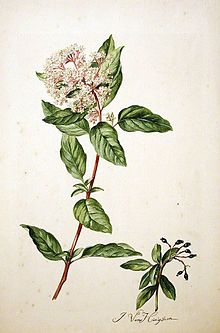Jacob van Huysum
| Jacob van Huysum | ||
|---|---|---|
 | ||
| Información personal | ||
| Nacimiento |
1687 Ámsterdam (Países Bajos) | |
| Fallecimiento |
1740 Londres (Reino de Gran Bretaña) | |
| Nacionalidad | neerlandés | |
| Familia | ||
| Padre | Justus van Huysum | |
| Información profesional | ||
| Área | pintura, acuarela, copista | |
| Género | Pintura floral | |


Jacob van Huysum (ca. 1687 Amsterdam - 1740 Londres) fue un artista botánico neerlandés.
Con su padre Justus van Huysum (1659–1716), y su hermano Jan van Huysum (1682–1749) fueron celebrados pintores de flores. Su manera de pintar era muy parecida a la de su hermano. Su acercamiento a la ilustración botánica, logró preservar al mismo tiempo la precisión botánica, y capturando un aspecto muy pictórico del tema. Esto contrastaba con el modo exacto y meticuloso de Georg Dionysius Ehret, su contemporáneo colega.
Jacob arrived in England in about 1721, and for a while lived in the house of his patron, Mr. Lockyear of South Sea House. Later he enjoyed the patronage of Sir Robert Walpole, who befriended him, and commissioned him to paint decorative works for his house at Houghton in Norfolk. More importantly he produced most of the 50 illustrations for John Martyn's Historia Plantarum Rariorum (London: 1728-38), and all the drawings for Catalogus Plantarum, an index of trees, shrubs, plants and flowers (London: 1730).
Historia Plantarum Rariorum depicted plants from the Chelsea Physic Garden and the Cambridge Botanic Garden. These plants had come from the Cape of Good Hope, North America, the West Indies, and Mexico. Elisha Kirkall produced the mezzotint engravings. Each plate was dedicated to a patron and showed an engraved coat-of-arms or monogram. Besides van Huysum, other artists were William Houstoun, Massey, G. Sartorys, and R. Sartorius. The work was published in five parts of ten plates each between 1728 and 1737, and was sold by subscription. The venture was not a financial success and publication ceased in 1737.
Fuentes
Véase también
-
Historia Plantarum Rariorum
Enlaces externos
 Wikimedia Commons alberga una categoría multimedia sobre Jacob van Huysum.
Wikimedia Commons alberga una categoría multimedia sobre Jacob van Huysum.

